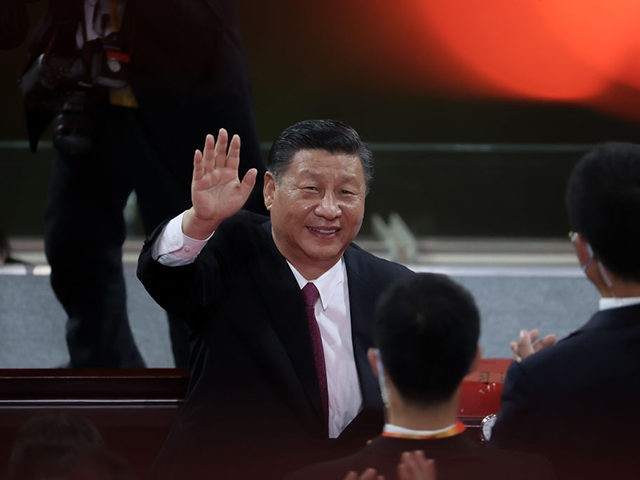Chinese leader Xi Jinping visited Tibet for the first time since 2011 on Wednesday to laud the Chinese Communist Party (CCP)’s progress in assimilating the Himalayan region to Han ethnic culture since China launched an occupation of the majority Buddhist territory in 1950, China’s official state-run Xinhua press agency reported Friday.
Chinese state media waited 48 hours to officially report that Xi had arrived in Tibet on July 21. His unannounced visit to Tibet shocked observers worldwide, as China is currently reeling from record-breaking floods across its north-central and southwest regions, including in Sichuan province, a region of China directly bordering Tibet. The “once in a thousand years” floods have killed at least 51 people in central China, though the death toll from the historic flooding is likely much higher than state outlets have reported.
China’s Global Times mentioned Sichuan province in its July 23 report on Xi’s visit to Tibet, though the CCP mouthpiece failed to report on the region’s recent flooding, which is due in part to the Chinese government’s construction of dams on China’s Yellow River in recent decades. The poorly planned and constructed dams have cut off vital connections between the waterway and adjacent rivers and lakes, disrupting floodplains that naturally absorbed much of China’s annual summer rains. The Global Times addressed none of this on Friday, instead choosing to highlight a railway project linking Sichuan province with Tibet.
“On Thursday, Xi went to Nyingchi railway station, learning about the overall design of the Sichuan-Tibet Railway and the Lhasa-Nyingchi railway section, which started service in June, and then took the newly opened train to Lhasa. He inspected the construction along the railway during the ride,” Xinhua reported. “Officially put into operation last month, the Lhasa-Nyingchi railway is Tibet’s first electrified railway.”
“Nyingchi is an important and strategic transportation hub along the Sichuan-Tibet Railway, which extends more than 1,740 kilometers from Chengdu, capital of Southwest China’s Sichuan Province, to Lhasa [Tibet’s capital],” according to the Global Times.
“A major and strategic section of the railway that connects Lhasa with Nyingchi started operating in June, where China’s most advanced Fuxing bullet train for the first time ran on the Qinghai-Tibet plateau and passed through the Yarlung Zangbo River,” the newspaper detailed. The Global Times’s decision to spotlight the Sichuan-Tibet railway line’s route through a river was notable, as the majority of the 55 people killed by floods on Tuesday in the central Chinese city of Zhengzhou tragically drowned after becoming trapped inside a deluged subway system.
“The Sichuan-Tibet Railway, once completed, will reduce travel time from other regions to Tibet by 30 percent. It will also cut travel time from Chengdu to Lhasa from 48 hours to 13 hours,” the Global Times further noted on Friday.
Xi visited Tibet for three days from July 21-23. In addition to riding the Sichuan-Tibet Railway line on July 22, Xi participated in several other events and highly staged photo ops during his tour of the region.
“Xi arrived at the Nyingchi Mainling Airport [in eastern Tibet] on Wednesday and was warmly welcomed by local people and officials of various ethnic groups,” the Global Times reported. “He then visited the Nyang River Bridge to inspect the ecological preservation in the basin of the Yarlung Zangbo River and its tributary Nyang River.”
“Xi also made an inspection tour of Lhasa on Thursday. He visited the Drepung Monastery, Barkhor Street and the Potala Palace square in Lhasa to learn about the work on ethnic and religious affairs, the conservation of the ancient city, as well as the inheritance and protection of Tibetan culture,” according to the communist outlet.
“Promoting the high-quality development of Tibet should be based on the principle that all development is to facilitate ethnic unity and progress, to improve livelihood and unite people, and to elevate the sense of gain, safety and happiness of all ethnic groups,” Xi told Chinese state media outlets on July 23.
Xi met with “representatives of the Tibet Military Command of the Chinese People’s Liberation Army [PLA] on Friday,” according to the Global Times. During the meeting, Xi “stressed that the local troops should fully strengthen the work of training soldiers and war preparation, and contribute positive strength to promote the long-term stability and prosperity of Tibet.”
China and India, which borders Tibet to its south, have been engaged in a border standoff along their Himalayan boundary since May 2020. The conflict began, in part, after both sides accused the other of building excess infrastructure projects — such as roads, tunnels, and bridges — that allegedly encroached upon the unmarked boundaries of their sensitive Himalayan divide. The dispute turned deadly in June 2020 after Chinese PLA troops ambushed an Indian border regiment in the northern Indian state of Ladakh. The skirmish resulted in the deaths of 20 Indian soldiers and an estimated 40 Chinese PLA members and caused ongoing border tensions, including in China’s strategically occupied Tibet. Like Xi on Wednesday, Chinese Foreign Minister Wang Yi made a “rare” visit to Tibet in August 2020 amid the backdrop of the China-India border standoff, ostensibly to reassert a Chinese presence in the Himalayan region.
Reports in May indicated China was increasing deployments of military equipment to its border with India after seemingly retreating from the Himalayan region last winter.

COMMENTS
Please let us know if you're having issues with commenting.